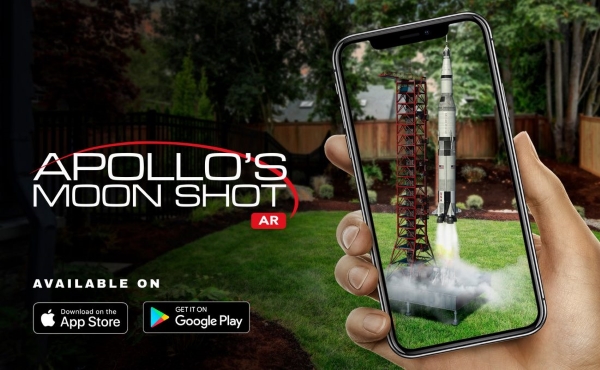[Several organizations have used different technologies to reproduce aspects of the July 1969 Apollo moon shot; the short story below from Space.com describes the Smithsonian’s “Apollo’s Moon Shot AR” app; more information about it, including a 2:00 minute video, is available from the Smithsonian website.
Engadget has a story about Google’s celebrations, including an “AR in Search” feature that lets you “explore a 3D recreation of the [Apollo 11] command module… If you like, you can bring the module into your living room in AR too.”
USA Today is offering “an eight-day live AR broadcast focusing on six historical events from [the] moon landing. From liftoff to landing, users will get to view the mission in real-time just as it happened 50 years ago” and a separate AR experience “in the USA TODAY mobile app telling the story of the hardware and technology that was used by NASA for the Apollo 11 mission.”
A press release from the National Air and Space Museum in Washington, D.C. has details of an ambitious projection mapping event on the National Mall: “For three nights, July 16, 17 and 18 a full-sized, 363-foot Saturn V rocket will be projected onto the east face of the Washington Monument from 9:30 p.m. to 11:30 p.m. On Friday, July 19, and Saturday, July 20, a special 17-minute show, ‘Apollo 50: Go for the Moon’ will combine full-motion projection-mapping artwork on the monument and archival footage to recreate the launch of Apollo 11 and tell the story of the first moon landing… The viewing area will be outfitted with full sound, projection screens and a 40-foot-wide recreation of the famous Kennedy Space Center countdown clock.”
And Lifewire has a first-person report that describes what happened when “[T]he Smithsonian Channel invited [the author] (and hundreds of others) to a midtown New York City event space where we could experience the 1960s America that witnessed the Apollo 11 launch and landing.”
–Matthew]

[Image: Source: Immersion]
Smithsonian Channel Crafts Augmented Reality Game for Apollo Moon Landing Fans
Steer your way to the surface or call blastoff on a Saturn V rocket.
By Passant Rabie
July 10, 2019
Commander Neil Armstrong and Lunar Module pilot Edwin “Buzz” Aldrin had to travel approximately 238,855 miles (384,400 kilometers) to land on the moon, but a new mobile app brings the moon right to your backyard.
The Smithsonian Channel recently released an immersive augmented reality (AR) app that re-creates the full timeline of the Apollo missions, allowing users to relive history for themselves.
“It was important for us to do justice to the story,” Charles Poe, senior vice president of production for Smithsonian Channel, told Space.com.
The “Apollo’s Moon Shot AR” app is based on the channel’s six-part television series, “Apollo’s Moon Shot,” which follows the journey of the moon landing program. The game is an extension of the stories told in the series, according to Poe, using augmented reality to bring people into the history.
And people are literally brought into it. Through their mobile or tablet, players can set up a portal to the moon wherever they are, step into the projection and transport themselves to a new world where they can walk around and explore their surroundings.
Once they’ve traveled to the moon, users get to pick their own missions, from piloting the Apollo lander to the moon’s surface, shooting off a Saturn V rocket or launching a rocket from Earth all the way to the moon without running out of fuel.
“You want it to be challenging, living up to the real achievement,” said Poe.
Using AR tools that were created in collaboration with Immersion, a European company that specializes in this type of technology, the team at the Smithsonian Channel re-created the lunar surface and surrounding artifacts as accurately as possible.
Experts at the Smithsonian reviewed the game’s programming to ensure that the scenarios that were created were true to life.
“That’s one of the things that sets us apart,” said Poe. “We wanted to make sure we were giving viewers a different perspective by creating that exact scenario.”
The app is available through the iOS app store and on Google Play.
Leave a Reply